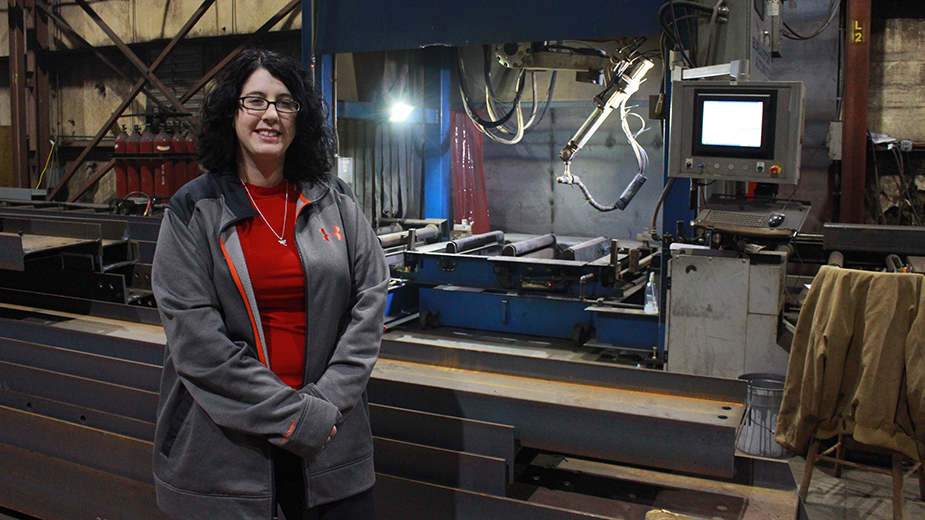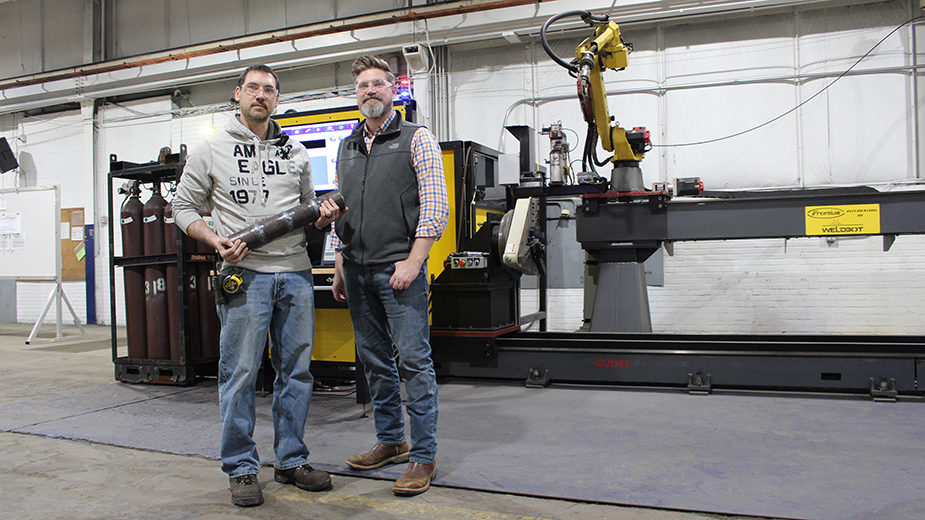YOUNGSTOWN, Ohio – Trends like automated robots on the manufacturing floor or offices hiring virtual assistants from the Philippines aren’t widely adopted in the region.
But dwindling job applicants and a greater need for efficiency over the last two years have led area companies to explore such technology-based solutions. And local IT companies see an uptick in customers seeking guidance on how to do it right.
Avrem Technologies LLC in Canfield has seen more customers adopt remote work options, which are attractive to younger job seekers, says owner and CEO Robert Merva.
Of Avrem’s customers, “Twenty percent really don’t care where the employees work from.” Another 40% have adopted a hybrid model. “It does give you a broader range of talent that you can pull from,” Merva says.
But remote work isn’t an option for manufacturers. Local manufacturers are finding ways to leverage IT and tech solutions to improve efficiency and manage costs.
Tech in Manufacturing
Livi Steel Inc. in Warren, wasn’t having luck in hiring form fitters to increase production and ease some of the burden on its incumbent workforce, says Ashley Morrow, payroll/human resources manager. To expand production capacity, company president Donald Livi looked into automation.
In mid-October, the steel manufacturer bought and installed a PythonX robotic computer numerical control, or CNC, plasma-cutting system. The system allows workers to complete in minutes what normally took an hour.
“Every day it amazes me,” Morrow says. “The quality of the material, the way it makes things more efficient and the way it makes the fitter’s job easier because it’s already doing A, B, C and D. So now they just have to do E and F.”
Automation reduces human error that could scrap a project, she says. It also relieves operators of repetitive motions that could lead to injury later in their lives.
Executive Computer Management Solutions Inc., or ECMSI, works with its manufacturing customers to monitor high-tech equipment like robotics, says Jerry Savo, chief financial officer.
Some equipment can be linked to Wi-Fi. So it’s imperative to keep that signal strong and prevent breaches to avoid downtime, Savo says.
Robotics increased efficiency at Livi Steel and put the company in a position to take on additional work, requiring more workers, Morrow says.

The company needs to hire at least three more fitters and could use three more in another month or two.
“I think when people hear ‘automation’ they think, ‘Oh my god, you’re going to lay them off,’ ” she says. “That’s not the case. We still need to expand our workforce.”
Current workers learned new skills to use the equipment, moving them up the ladder “and moving up the pay scale and the benefits,” Morrow says.
Transparency is key to effecting this type of automated equipment, she says.
Before the PythonX was installed, Donald Livi made clear to the workers that he was doing it to make their lives easier and strengthen job security by increasing capacity.
“I’ve seen such an increase in our morale,” Morrow says. “One guy ended up going and buying a new truck and he’s like, ‘I’ve never bought a new truck in my life.’ ”
Before making a purchase, companies should consider if they can afford the equipment, she says. They need to crunch the numbers to know if they can recoup the cost of the equipment and understand that “it might not be overnight,” she says.
Matthew Foerster agrees.
Foerster, sales manager for Starr Manufacturing Inc. in Vienna, says companies also need to account for the human investment – the time it takes to train the workforce to use the new systems, or hire those who can.
“You have to look for and develop a human brain trust who is somewhat experienced, but also somewhat new and fresh-minded and is willing to step into that next arena,” Foerster says.
Starr Manufacturing’s new robotic welding cell does the work of four human welders, he says. The goal is to maintain its current levels of output and to potentially increase capacity amid a shortage of welder applicants.
So-called “cobots” – robotic welding units working alongside human operators – are Starr’s current and future solution for adapting to workforce challenges. The company looks to effect another such system this year or next.
“We’re not reducing our headcount,” Foerster says with emphasis. “We’re just trying to add capacity because the people simply aren’t here.”
ECMSI, based in Struthers, handles all of Starr’s in-house IT heavy lifting, Foerster says. Security is a major factor for Starr and ECMSI alleviated attempted breaches with virus protection software.
Manufacturers are concerned about security just as much as other industries, says ECMSI’s Savo. Improving efficiency is also a key goal.
“Their margins are, in a lot of ways, smaller than a lot of other companies,” Savo says. “In this competitive global market, they really have to be as efficient as possible.”
Starr Manufacturing is in the midst of upgrading its enterprise resource planning, or ERP, software, which
integrates its computer-aided drawing, or CAD systems to its project management systems, streamlining projects.
“So all of that duplicate data entry, and sometimes the human error that creeps in when you do data entry, is predominantly eliminated,” Foerster says.
At peak business levels, that efficiency equates to almost one full-time job, he says. “So now we can have the same headcount but achieve more and sell more.”
An artificial intelligence component allows for simpler scanning and sorting of hard copy documents as well.
Foerster operates the system, although he would like to hire someone to fill that role, he says. Because the system is so new, it can be difficult finding applicants with ERP experience. Notable traits sought include project management, scheduling and data entry with a knowledge of manufacturing.
Going Remote, Locally and Abroad
Like many offices, Gem-Young Insurance & Wealth Advisors LLC adopted remote work options during the pandemic, CEO Leo Daprile Sr. says
The agency recently hired its first virtual assistant from the Philippines to support its account managers, bringing additional technological challenges, Daprile says. Since Gem-Young couldn’t connect the worker to its phone system, the agency had to rely on cloud-based solutions.
Gem-Young works with Avrem Technologies to establish and monitor those solutions.
The first step is to establishing a virtual private network, or VPN, which allows companies to connect to a private network using a public network, Merva says.
Replacing physical servers with cloud services benefits remote work as well. Solutions like Office 365 have become a “game-changer,” he says.
Virtual assistants aren’t a novel concept. But they can benefit companies struggling to find workers.
“Last time I was hiring an account manager three or four years ago, when I put an ad out, I quit counting resumes at 298,” Daprile says. “The last round, over six weeks I got maybe 50.”
When hiring a virtual assistant, Daprile recommends working with agencies that specialize in recruiting and training those workers.
While Gem-Young was involved in final interviews and providing virtual training modules, the company it worked with handled the rest.
“Make sure you’re clear of what it is you want this employee to do,” he says. “Make sure you understand the company that you’re working with and what their processes are for training.”
When possible, Merva recommends employers issue company-owned hardware to remote workers. That ensures easier management, better security and the employees aren’t using devices that are too old.
“There’s not a whole lot we can do as an IT company if you’ve got an employee who wants to use their 10-, 15-year-old computer to dial into a work network,” he says.
Businesses might need to pay for stronger internet connections for their remote workers as well, Merva continues.
As Avrem aids customers as they establish remote work infrastructures, he is amazed at how many people use weak internet connections at home.
Some workers live “out in the middle of nowhere” and can’t access high-speed internet, he says.
Others live in an area where strong internet is prevalent but they don’t use it.
“We saw some DSL connections that we hadn’t seen in 15 years,” he says. “We saw some dial-up in a couple of instances, which I didn’t know even existed anymore.”
With its own remote endeavors, communication was Avrem’s biggest challenge, Merva recalls. However, messaging tools like Slack and Microsoft Teams alleviated that issue.
Microsoft Teams helped Easterseals of Mahoning, Trumbull & Columbiana Counties collaborate remotely and save time as well, says office administrator Christine Santangelo. The trick, she says, was getting staff to use the training modules for the software.
“When you’re so overwhelmed and busy, it’s hard to get people to stop to take that time to take the training,” Santangelo says.
She emphasized to her co-workers that the solutions would improve worker efficiency.
“As a nonprofit, we get a lot of funds from donations, from grants and things like that,” she says. “I’ve always felt that working for a [nonprofit], I want to use every bit of money that’s given to us wisely. And if I’m not working efficiently, I feel like I’m wasting money.”
ECMSI aided Easterseals in rolling out new electronic medical records software to improve the efficiency of its outpatient rehabilitation services. It looks to extend the software to its adult day center, Santangelo says.
Financing such purchases is a challenge for nonprofits. Santangelo recommends organizations consider sources such as TechSoup, a nonprofit that provides software downloads at a discounted rate.
“It’s been very helpful for us,” she says. “We’re able to get the Office suite for a very reasonable price compared to what we would have if we paid full price.”
Pictured: At Starr Manufacturing, Ron Kester operates and programs the new robot welding cell, which does the work of four human welders, says Matthew Foerster.
